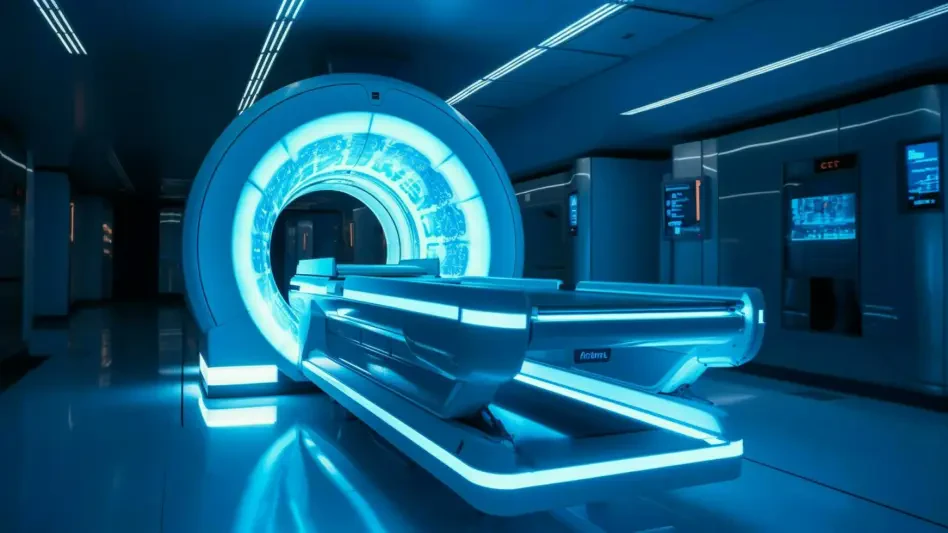In the realm of medical imaging, the quest for safer and more sustainable technologies has become a pressing concern, with the global MRI contrast agent market valued at over $1.5 billion and growing rapidly. Traditional gadolinium-based contrast agents, while effective, have raised alarms due to potential toxicity and environmental persistence, leaving patients and healthcare providers seeking alternatives. This review dives into the emergence of manganese-based MRI contrast agents, spotlighting innovations like BVR-19, a metal-organic framework (MOF) that promises to revolutionize diagnostic imaging with enhanced safety and eco-friendliness. The exploration ahead unpacks how this technology addresses critical challenges and reshapes the landscape of non-invasive diagnostics.
Introduction to Manganese-Based MRI Contrast Agents
Manganese-based MRI contrast agents have emerged as a compelling substitute for gadolinium-based options, which have dominated the field for nearly four decades. Unlike gadolinium, a rare earth metal with documented retention risks in human tissues, manganese is an abundant trace element naturally present in the body and essential for metabolic functions. This fundamental difference positions manganese as a safer core material for enhancing MRI image clarity while mitigating health concerns.
The development of these agents comes at a pivotal moment when the medical imaging community is grappling with both patient safety and environmental impact. Gadolinium’s persistence in wastewater and its potential to accumulate in ecosystems have spurred a demand for greener alternatives. Manganese-based solutions aim to address these dual challenges, aligning with broader industry goals of sustainability and reduced toxicity in diagnostic tools.
This shift also reflects a response to regulatory scrutiny, such as warnings from the U.S. Food and Drug Administration about gadolinium retention. By leveraging a biocompatible metal, researchers have opened a pathway to contrast agents that minimize long-term risks. The focus on manganese underscores a transformative approach to balancing efficacy with ethical considerations in medical technology.
Key Features and Innovations of Manganese-Based Agents
Biocompatibility and Safety of Manganese
Manganese stands out as a biocompatible element, integral to human health in small amounts for processes like bone formation and enzyme activity. Unlike gadolinium, which can linger in the body for extended periods even in individuals with healthy kidney function, manganese is metabolized more efficiently, reducing the likelihood of harmful accumulation. This inherent safety profile makes it an attractive choice for contrast agents, particularly for vulnerable patient populations.
The reduced toxicity risk associated with manganese addresses a critical concern in medical imaging. Gadolinium’s potential to cause adverse effects, though not fully understood, has prompted mandatory patient education in clinical settings. In contrast, manganese-based agents offer a reassuring alternative, minimizing the need for such precautions while maintaining the ability to enhance diagnostic precision.
Furthermore, the abundance of manganese in the Earth’s crust alleviates supply chain vulnerabilities tied to rare earth elements like gadolinium, much of which is sourced from limited global regions. This accessibility not only enhances safety but also supports a more stable production pipeline for contrast agents, ensuring broader availability for healthcare systems worldwide.
Structural Design of Metal-Organic Frameworks (MOFs) like BVR-19
At the forefront of manganese-based innovation is BVR-19, a metal-organic framework that integrates manganese with L-cystine, a naturally occurring amino acid. MOFs are characterized by their nanosized porous structures, formed by metal ions connected through organic linkers, allowing for tailored functionality. BVR-19’s design optimizes imaging performance by enhancing signal brightness at significantly lower doses compared to traditional agents.
A standout feature of BVR-19 is its environmentally conscious synthesis process, conducted in water at room temperature without toxic solvents or harsh conditions. This green chemistry approach reduces the ecological footprint of production, aligning with growing calls for sustainable practices in medical technology. The result is a contrast agent that prioritizes both patient well-being and planetary health.
Testing of BVR-19 has demonstrated superior image clarity, offering sharper visuals that aid in precise diagnostics. This efficiency at reduced dosages not only lowers potential exposure risks but also cuts costs for healthcare providers. The structural ingenuity of MOFs like BVR-19 marks a significant leap in redefining the standards of MRI contrast media.
Recent Developments in MRI Contrast Technology
The landscape of MRI contrast technology is undergoing a profound transformation, driven by a push for sustainability and safety. Recognition of MOFs through prestigious accolades, such as the Nobel Prize for Chemistry this year, underscores their versatility and potential across scientific domains. This acknowledgment highlights the role of advanced materials in addressing long-standing challenges in medical imaging.
Emerging trends in green chemistry are shaping the development of contrast agents, with an emphasis on minimizing environmental harm. From reducing wastewater pollution to adopting eco-friendly synthesis methods, the industry is witnessing a paradigm shift toward responsible innovation. Manganese-based agents like BVR-19 exemplify this movement, offering a blueprint for future advancements in the field.
Collaborative research efforts, involving interdisciplinary teams from academic and health institutions, further accelerate progress. Support from funding bodies and scientific communities has enabled rigorous testing and refinement of these technologies over recent years. As a result, the trajectory from 2025 onward promises accelerated adoption of safer, more sustainable imaging solutions in clinical settings.
Applications and Impact in Medical Imaging
Manganese-based contrast agents are making a tangible impact in medical imaging by enhancing the clarity of MRI scans for non-invasive diagnostics. Their ability to produce brighter images at lower doses translates to more accurate detection of abnormalities, from neurological conditions to soft tissue injuries. This precision is critical for early intervention and improved patient outcomes across diverse medical specialties.
Beyond technical performance, these agents address a pressing industry need for safer diagnostic tools. Hospitals and imaging centers globally are under increasing pressure to adopt solutions that reduce patient risk and align with regulatory guidelines. Manganese-based options provide a viable pathway to meet these demands without compromising on quality or accessibility.
The environmental benefits of such agents also resonate with healthcare providers aiming to curb pollution from contrast media. By avoiding the ecotoxicological risks associated with gadolinium, which persists in treatment plants, these innovations support cleaner hospital wastewater management. Their deployment marks a step toward harmonizing cutting-edge diagnostics with ecological responsibility.
Challenges and Limitations of Manganese-Based Agents
Despite their promise, manganese-based MRI contrast agents face several hurdles in achieving widespread clinical adoption. Technical challenges, such as optimizing stability and consistency across diverse patient populations, remain a focus of ongoing research. Ensuring uniform performance under varying conditions is essential for gaining trust among radiologists and healthcare systems.
Regulatory pathways present another obstacle, as new contrast agents must undergo rigorous evaluation to meet safety and efficacy standards. Navigating these approval processes can delay market entry, even for promising technologies like BVR-19. Harmonizing global standards for clinical use adds further complexity to the rollout of these innovations.
Market barriers, including resistance to change from established gadolinium-based protocols, also pose challenges. Convincing stakeholders of the long-term benefits of switching to manganese-based agents requires robust data and education efforts. Continued investment in research and pilot programs is crucial to overcoming these limitations and paving the way for broader acceptance.
Future Outlook for Manganese-Based MRI Contrast
Looking ahead, the trajectory of manganese-based contrast agents appears poised for significant breakthroughs in material synthesis and application. Advances in tailoring MOF structures could further enhance imaging capabilities, potentially unlocking new diagnostic possibilities for complex conditions. The focus on precision design holds promise for even greater efficiency in clinical environments.
Broader clinical applications are also on the horizon, with potential expansions into specialized imaging techniques and personalized medicine. As research progresses from 2025 to the coming years, integration with emerging technologies like artificial intelligence could optimize image analysis and interpretation. Such synergies may redefine diagnostic workflows for the better.
The long-term impact of these agents lies in their ability to transform medical imaging into a safer, more sustainable field. By reducing reliance on toxic materials and embracing green practices, the industry can prioritize both human health and environmental stewardship. Manganese-based solutions stand as a cornerstone of this evolving vision, with far-reaching implications for global healthcare.
Conclusion and Key Takeaways
Reflecting on this exploration, manganese-based MRI contrast agents like BVR-19 prove to be a transformative force in medical imaging, blending safety with high performance. Their development marks a critical response to the drawbacks of gadolinium, offering a biocompatible and eco-friendly alternative that does not sacrifice diagnostic quality. The journey of these innovations showcases a remarkable fusion of materials science and green chemistry.
Moving forward, stakeholders should prioritize accelerated research to address remaining technical and regulatory challenges, ensuring swift integration into clinical practice. Investment in educational initiatives for healthcare professionals could ease the transition from traditional agents, fostering confidence in new protocols. Collaborative efforts between academia, industry, and policymakers will be vital to scaling adoption.
Additionally, attention to public awareness about the environmental benefits of such technologies could drive demand for sustainable diagnostics. Advocating for policies that incentivize greener medical solutions might further cement the legacy of manganese-based agents. These actionable steps chart a clear path toward a future where imaging technology harmonizes innovation with responsibility.









